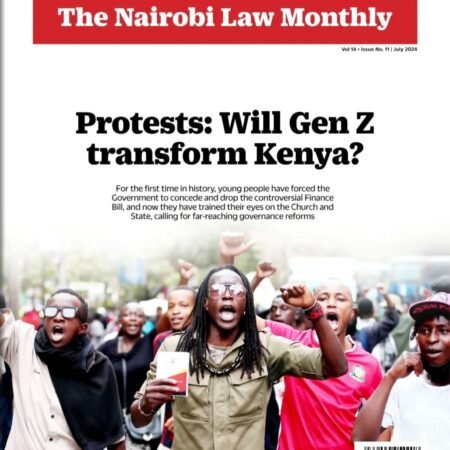-
Sale!
Download Nairobi Law Monthly Magazine July 2024 Edition
Downloads Original price was: KShs200.00.KShs100.00Current price is: KShs100.00.
By Tom Odhiambo
The Somali are a people Kenyans love to have, if we accept the cliché. On the one hand the Somalis bring you all the little goods that we would wish to buy but can’t afford on the main street. So, we have loved the Somalis in Eastleigh, for helping us buy that flat screen TV, latest smartphone or “designer” suit. But we also suffer from a severe case of seeing in one Somali all Somalis. Kenyans casually talk about Somalis as if they are terrorists where al Shabaab is concerned.
We aren’t the only ones who stereotype Somalis though. In fact, the Somalis themselves have interesting stereotypes of non-Somalis. But one imagines that the one reason the Somalis fascinate and strike fear in Kenyans is because they are a people with more stamina for survival than us. We are apprehensive of their ability to survive in adversity. What does that mean for us if they take over our businesses, if they dominate us? Jonny Steinberg captures the spirit of survival among the Somali in his book A Man of Good Hope (Jonathan Ball, 2014).
A Man of Good Hope is the story of Asad Abdullahi. Asad leaves Mogadishu in 1991 when the civil war in Somalia is very intense. He is 8 years old. He leaves with his family but loses them on the way as often happens with people fleeing war. His life becomes one of an itinerant. From Mogadishu he moves to Liboi refugee camp then Eastleigh in Nairobi then Dire Dawa and Addis Ababa in Ethiopia, back to Nairobi, then through Tanzania, Zambia, and Zimbabwe to South Africa from where Abdi is resettled in America.
Steinberg writes an epic story that interlocks the lives of hundreds of people in what is known as the Somali Diaspora. Right from Mogadishu, Steinberg mixes history with oral testimony/witness accounts, personal observation, media reports and authorial creativity. What you read in A Man of Good Hope is the drama of political upheavals, mass displacements, refugee camp life with its suffering, death, survival, movement; illegal border crossings, life in alien lands…
The big story here is that of resilience. Asad’s is a story of losing one’s relatives and finding oneself “alone” in the world. In such a case, one has to “grow up” faster than a normal child would. Asad is forced by circumstances to try and locate his relatives in Ethiopia, where his family originally came from. His kin are part of the larger Ogaden Somalis. It is in Ethiopia, in Addis, that he realises that he has to become a man and try to determine his destiny. He becomes a hustler, a city fixer for newly arrived Somalis. Here he makes a living and cares for other boys without families. It is here where he marries one Foosiya.
But Asad is a traveller for really he has no home – is home the Ogaden in Ethiopia or is it Mogadishu? When Asad thinks he has made enough money to travel, he sets out to try and reach South Africa, with his most desired destination being America. This journey proves to be a tough one, involving people smugglers, corrupt policemen and immigration officers and difficult fellow travellers. Asad, however, manages to reach Johannesburg and to start a new life in South Africa as a trader.
Social-economic fissures
Yet violence shadows Asad even in South Africa where he believed he would get a new life, free from need, hopelessness and violence. Whereas at home he is faced with the tyranny of clan suspicion and violence, in South Africa the demons of xenophobia haunt him. Asad is a victim of racism in a country whose black population had suffered centuries of discrimination. So, when he opens a kiosk – popularly called Spaza shop – in rural South Africa, he ends up closing it because of the violence from the local unemployed youth. His uncle, who had started him off in South Africa, is shot dead one day and Asad’s life nearly crumbles.
Asad would come to realise that he has to live with the violence of black South Africans who accuse the kwerekweres – foreigners from up north of River Limpopo – of taking over their jobs at low pay, running businesses and sending the money abroad, marrying their women and helping push them down the socio-economic ladder. Steinberg uses Asad’s story to illustrate the social and economic fissure that strains South Africa today. In the same breath, he shows how Africans from the rest of the continent survive discrimination, robbery, violence or even death as they try to make a living in the relatively richer South Africa.
A Man of Good Hope is Asad’s story but it is also the story of the Somali – even though it sounds like a cliché. It is the story of the Somali people because you get to know how the Somali network – spread all over the world – easily takes in “relatives” and finds them a place to live as they plan what to do next. This is how Asad uses his Ogaden and Daarood roots to survive the tempests of time and place. It is these connections, which thrive on trust, solidarity and community affiliation, which guarantee one continued existence.
Finally though, this is also the story of what bad governance, war, displacement, migration, and such other vagaries of life do to people such that even though in the end Asad is settled in Texas, USA, his identity remains that of a refugee. Steinberg describes “refugee” (Asad) this way, “When he told me his story he did so in the words of a refugee, for these are the words he must use, always, at every border post he approaches, at every government office outside of which eh queues. A refugee has lost control. Great historical forces have upended him and he no longer has a place in the world. He has become an in-between sort of being, suspended between the past in which he belonged somewhere, and a future in which he might belong somewhere once more. But for now he is in abeyance; he is swept this way and that, like flotsam in a tide.”


